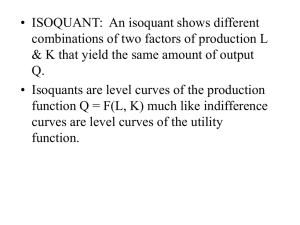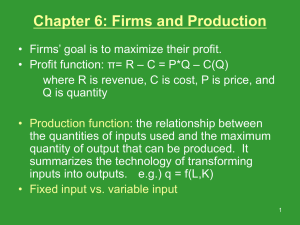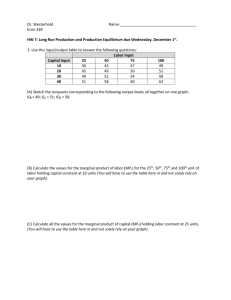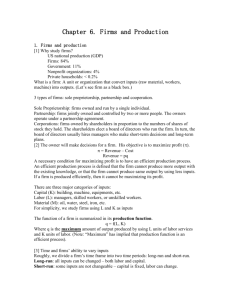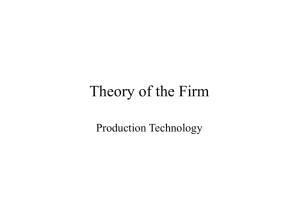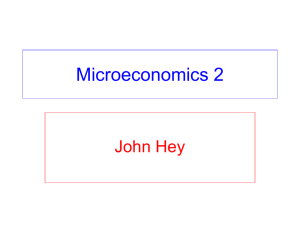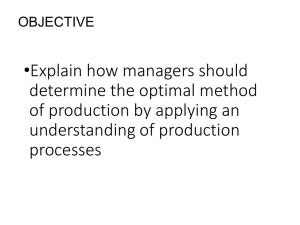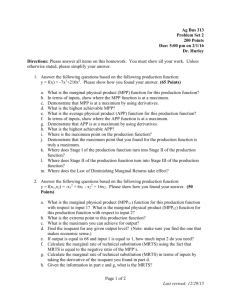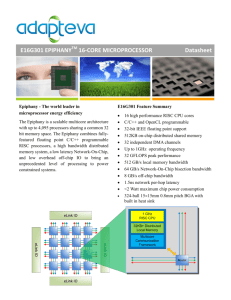Production Functions Production Function Marginal Product
advertisement
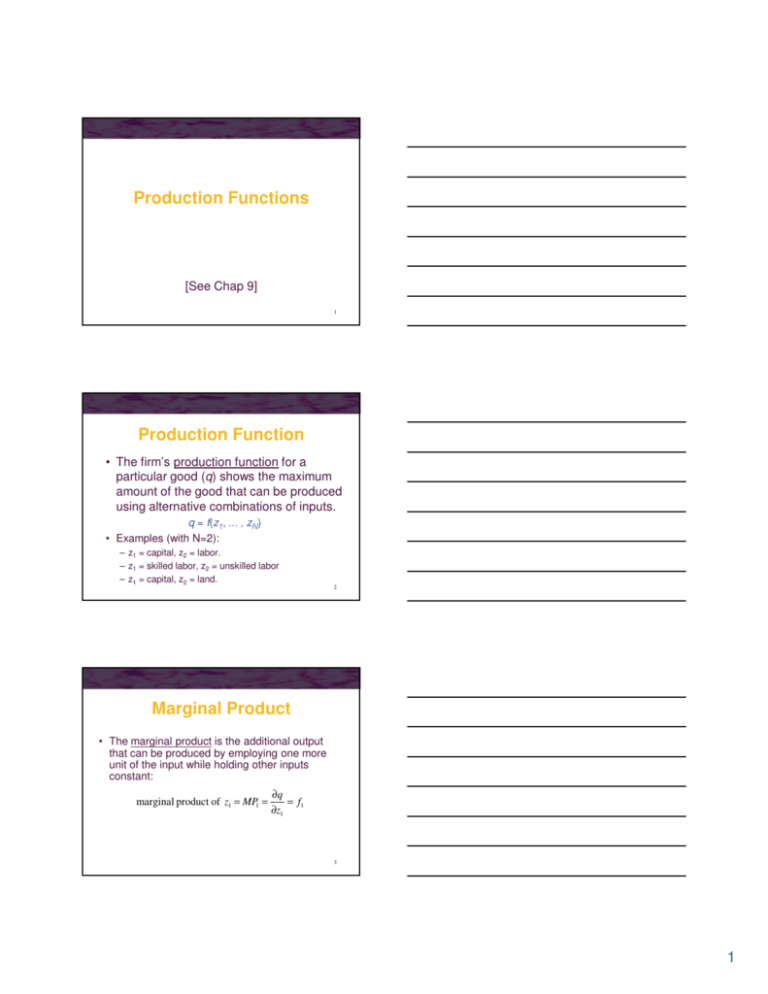
Production Functions [See Chap 9] 1 Production Function • The firm’s production function for a particular good (q) shows the maximum amount of the good that can be produced using alternative combinations of inputs. q = f(z1, … , zN) • Examples (with N=2): – z1 = capital, z2 = labor. – z1 = skilled labor, z2 = unskilled labor – z1 = capital, z2 = land. 2 Marginal Product • The marginal product is the additional output that can be produced by employing one more unit of the input while holding other inputs constant: marginal product of z1 = MP1 = ∂q = f1 ∂z1 3 1 Average Product • Input productivity can be measured by average product z2 AP1 = q f ( z1 , z 2 ) = z1 z1 4 ISOQUANTS 5 Isoquants • An isoquant shows the combinations of z1 and z2 that can produce a given level of output (q0) f(z1, z2) = q0 • Like indifference curves for technology. 6 2 Isoquants • Each isoquant represents a different level of output. z2 q = 30 q = 20 z1 7 Marginal Rate of Technical Substitution • The slope of an isoquant shows the rate at which z2 can be substituted for z1 • MRTS = number of z2 the firm gives up to get 1 unit of z1, if she wishes to hold output constant. z2 z2* - slope = marginal rate of technical substitution (MRTS) A B z2 In picture, MRTS is positive and is diminishing for increasing inputs of labor q = 20 Z1* z1 z1 8 MRTS • The marginal rate of technical substitution (MRTS) shows the rate at which labor can be substituted for capital while holding output constant along an isoquant MRTS = − dz 2 dz1 q = q0 9 3 MRTS and Marginal Products • Take the total differential of the production function: dq = ∂f ∂f ⋅ dz 2 + ⋅ dz1 = MP2 ⋅ dz 2 + MP1 ⋅ dz1 ∂z 2 ∂z1 • Along an isoquant dq = 0, so MRTS = − dz 2 dz1 = q = q0 MP1 MP2 10 PROPERTIES OF TECHNOLOGY 11 1. Monotonicity • A production function is monotone if f(z1,z2) is strictly increasing in both inputs. ∂f = fi > 0 ∂zi • This implies that – isoquants are thin – isoquants do not cross – isoquants are downward sloping. 12 4 2. Quasi-Concavity • Suppose z=(z1,z2) and z’=(z1’,z2’) are two input bundles. • f(.) is quasi-concave in z if whenever f(z)≥f(z’) then f(tz+(1-t)z’)≥f(z’) 1>t>0. • Implications – Isoquants are convex. – MRTS decreases in z1, as move along isoquant. 13 3. Concavity • Suppose z=(z1,z2) and z’=(z1’,z2’) are two input bundles. • f(.) is concave in z if f(tz+(1-t)z’) ≥ tf(z) + (1-t)f(z’) 1>t>0. • Implies quasi-concavity (convex isoquants). • Implies diminishing marginal productivity: ∂MP1 ∂ 2 f = 2 = f11 ≤ 0 ∂z1 ∂z1 ∂MP2 ∂ 2 f = = f 22 ≤ 0 2 ∂z 2 ∂z 2 • Implies constant or decreasing returns to scale. 14 4. Returns to Scale • How does output respond to increases in all inputs together? – suppose that all inputs are doubled, would output double? • The effect of a proportional change in all inputs on output is called the returns to scale 15 5 Returns to Scale • If the production function is given by q = f(z1,z2) and all inputs are multiplied by the same positive constant (t >1), then Effect on Output Returns to Scale f(tz1,t z2) = tf(z1,z2) Constant f(tz1,t z2) < tf(z1,z2) Decreasing f(tz1,t z2) > tf(z1,z2) Increasing 16 Returns to Scale • Why should there ever be DRS? – If expand all inputs then shouldn’t output at least double (just recreate what firm was doing before). – May be able to do better due to specialization (leading to IRS). • DRS can be seen as coming from omitted factor of production. For example, limited management time. 17 EXAMPLES 18 6 Perfect Substitutes • Suppose that the production function is q = f(z1,z2) = az1 + bz2 • Isoquants are straight lines. – MRTS is constant, since MP1=a and MP2=b. • Production function exhibits constant returns to scale f(tz1,tz2) = atz1 + btz2 = t(az1 + bz2) = tf(z1, z2) 19 Perfect Substitutes Capital and labor are perfect substitutes z2 slope = -a/b q1 q2 q3 z1 20 Perfect Complements • Suppose that the production function is q = min (az1,bz2) a,b > 0 • Capital and labor must always be used in a fixed ratio – the firm will always operate along a ray where z1/z2 is constant 21 7 Perfect Complements No substitution between labor and capital is possible z2 q3 q3/b q2 q1 q3/a z1 22 Cobb-Douglas • Suppose that the production function is q = f(z1,z2) = z1az2b a,b > 0 • Returns to scale f(tz1,tz2) = (tz1)a(tz1)b = ta+b z1az1b = ta+bf(z1, z1) – if a + b = 1 ⇒ constant returns to scale – if a + b > 1 ⇒ increasing returns to scale – if a + b < 1 ⇒ decreasing returns to scale 23 Generalized Subs/Comps • Generalized perfect substitutes q = f(z1,z2) = (az1 + bz2)γ • Generalized perfect complements q = f(z1,z2) = (min(az1,bz2))γ • Constant returns if γ=1. • Increasing returns if γ>1. • Decreasing returns if γ<1. 24 8 CES Production Function • Suppose that the production function is q = f(z1,z2) = [z1ρ + z2ρ] γ/ρ ρ ≤ 1, ρ ≠ 0, γ > 0 – If γ > 1 ⇒ increasing returns to scale – If γ < 1 ⇒ decreasing returns to scale • Special cases – If ρ = 1 ⇒ perfect substitutes – If ρ = -∞ ⇒perfect complements – If ρ = 0 ⇒ Cobb-Douglas 25 Example • Suppose that the production function is q = f(z1,z2) = z1 + z2 + 2(z1z2)0.5 • Marginal productivities are f1 = 1 + (z2/z1)0.5 f2 = 1 + (z1/z2)0.5 • Thus, MRTS = f1 1 + ( z2 / z1 ) 0.5 = f 2 1 + ( z1 / z 2 ) 0.5 26 Technical Progress • Methods of production change over time • Following the development of superior production techniques, the same level of output can be produced with fewer inputs: – In this case the isoquants shifts down. 27 9 Technical Progress • Suppose that the production function is q = A(t)f(z1, z2) where A(t) represents all factors that affect the production of q other than z1 and z2 – Changes in A over time represent technical progress – We would imagine that dA/dt > 0 28 10
